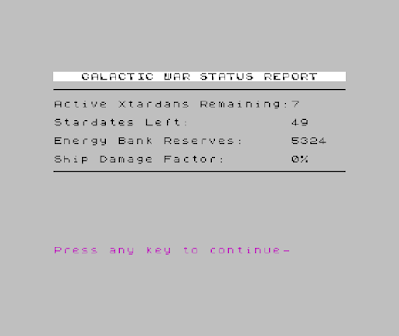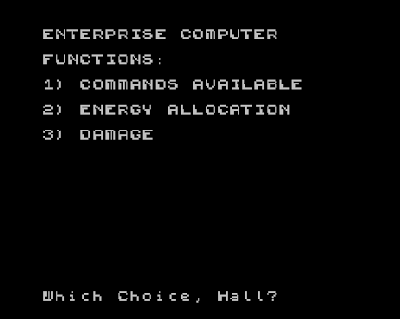Starfire at 40 - The 2nd Virgin Game
Hi everyone.
My first blog from 2 years ago was about the first game released by Virgin Games back in 1983.
Seeing that it's now 40 years later, it seemed appropriate to follow it up with the second game released by Virgin Games.
Starfire, for the Spectrum 48K, was released at the same time as Yomp along with 2 other games. They were Sheepwalk, a sheep herding game where you control a sheepdog, and Golf, which is, well, a game of golf.
All games were released for the Spectrum 48K, although Yomp and Golf could be played on a 16K machine.
Starfire's catalogue number is VGA1002, which is why I'm classing it as the 2nd game released.
Over the next few years, the catalogue numbers continued to be used, until about 1987/88, which seems to coincide with Virgin Games purchase of Mastertronic.
The concept of the catalogue numbers is relatively straightforward. They all start VG. The letter after this would indicate the price category of the game. The VGA games were all priced at £7.99 upon release.
For the numbers, the first number represents the computer type, with 1 being the Spectrum.
The cover is in a similar format to that of Yomp. The pink and blue diagonal stripes indicating it was a Spectrum game, the Virgin Games logo in the top left hand corner, the title in white above a comic style picture below. Finally, the indication of what computer the game was for at the bottom in black.
The picture shows a starship flying above an orange planet (or maybe a sun), narrowly avoiding 4 missiles with 2 explosions in the background. To the bottom left of that image, a picture of 2 men, assumedly at the controls of the starship.
The description on the rear reads:
STARFIRE: RID THE GALAXY OF THE XTARDAN BATTLE CRUISERS - A GAME OF STRATEGY AND SKILL by Martyn Charles Davis.
As before with Yomp, we'll get to know Martyn a little better later in the blog.
Starfire is the name of a space strategy based board wargame, released in 1979.
There was also an arcade game by Exidy, released in 1978, named Star Fire.
It appears that this game written by Martyn appears to be an homage to them, with gameplay elements linked to both, although not officially licenced by Virgin Games.
Opening up the inlay gives you the following prologue:
You are Commander of the only remaining EARTH SPACE AGENCY ship in the entire galaxy. The rest of your fleet has been wiped out by a powerful alien force leaving you to navigate the galaxy and destroy the alien fighters single-handed.
The future of civilization depends on you. You must succeed!
Those seem like pretty insurmountable odds, but no pressure. You got this Commander!
The screenshot of the game shows your starship and a starbase. There are indicators for Distance, Fuel and Velocity. A prompt states Thrust? (0-100%) with the number 36 having been input.
In truth, the screenshot shown is almost like a minigame. The main game doesn't look anywhere near as exciting, but this is a Spectrum game, so you do have to use some imagination to get the most out of it.
The instructions read:
Determine the degree of difficulty of your mission by selecting a skill level from android (1) to impossible (10).
Before this, the game prompts:
Please enter your name, Captain.
(standard Federation procedure)
Once you enter your name, you get to choose your difficulty level. Level 1 is actually an android with a Spectrum ZX80 brain. I would actually be fascinated to see an android using a ZX80 as a processor!
Your Galactic War Report will now detail the task ahead: the number of aliens you must wipe out, how many starbases you may land on to recharge your energy supplies, and the number of stardates (time) allowed.
Now climb aboard and press key c to call up your computer. It will list all the commands available to you:
Navigate - key n
The galaxy consists of a grid of 10 x 10 squares or quadrants, making 100 quadrants in all. The quadrant in the top left hand corner of your screen has co-ordinates 0,0 - the first representing the number of quadrants down, the second being the number of quadrants across the grid. By pressing 'n', your ship can move from one quadrant to another. But remember, navigating uses up both time and energy.
Should 'red alert' flash on your screen when in this mode, you have entered a quadrant where there is an alien fighter.
Battlestations - key b
Move into this mode only when in the same quadrant as an alien. Now manoeuvre your laser torpedo sight over the alien ship by pressing keys B, H, F and T, then press 4 to release your torpedoes.
Beware, the alien can fire back, or worse, can self-destruct taking your ship with him! So as soon as you see the flashing light marked SD on the bottom left of your display stop flashing, you have only 2 seconds to abort the attempt by pressing key a, or to destroy the alien.
Galactic War Report - key r
This gives an immediate update of your mission: how many aliens you have yet to destroy, the number of starbases and stardates left.
Computer Call - key c
The damage report gives a detailed account of your ship's damage and will show the percentage of your ship destruction factor.
Long Range Scan - key L
This allows you to see if there are any aliens or starbases in the quadrants adjacent to your own. Nine two-digit numbers will appear on the screen, the middle quadrant always being your own. The first of the two-digit numbers indicates the number of aliens in that quadrant, the second shows the number of starbases.
Smart Bombs - key s
These can only be used in the command mode, to destroy aliens in the same quadrant as your own, and in each adjacent one. (Warning: consumes a great deal of power, so use sparingly.)
Periodically it will be necessary to dock with a starbase to refuel, re-arm and to repair any damage. Make sure there are no aliens in the quadrant first however, and note that your shield value must be less than 2000 if you are to dock.
Press key d to enter the docking mode, and enter the required amount of retro-thrust from 0 to 100. To avoid being drawn in too quickly by the force of gravity, and crashing into the base, you must dock with a velocity of less than 10 m/s. If at any time you think you are being sucked in too quickly, press a to abort your attempt.
The galaxy is full of surprises designed to stretch your skills as commander to the limit. If you come across a time portal, use keys 6 (down) and 7 (up) to steer your ship.
Move through an asteroid storm by waiting until you see a clear path through the field, then press any key to get across.
As you can tell, this isn't an arcade style game, although there are arcade elements to some of the minigames you come across, such as the destroying the aliens with your laser torpedoes, navigating time portals and asteroid fields.
Where a game like Yomp would give you 5-10 minutes of entertainment, this definitely has the capability of giving you a lot longer playtime, albeit less intense.
Let's move on to our "Rock Star" programmer, Martyn Charles Davis.
Born in 1965 (making him only 18 when he wrote the game) in Longfield, Kent, he moved to Loughborough when he was 3.
At the time of the biography, he was studying A-level Biology, Chemistry, Physics and English Literature, with a plan to study medicine at university.
He started serious computing in 1981 (age 16) with a Spectrum ZX81.
He likes games like Backgammon and Chess.
Apart from computing, his hobbies are book collecting and guitar playing. His musical interests vary from classical to heavy rock.
He was very interested in wargaming, but it states in the biography "until recently", seeming to indicate he was no longer very interested in 1983.
In 1982, he had an article published in 'Military Modelling Magazine' on wargaming with the Spectrum ZX81.
Starfire was written in 3 solid weeks with the aim to create a complex, yet entertaining game to last more than an hour.
Martyn was apparently working on a series of adventure programmes. A search of MobyGames only seems to indicate one other game credit. The Island is a text adventure game also released by Virgin Games in 1983.
As with Yomp, there is a form you can complete to join the Virgin Games Gang and win up to £500 of computer hardware and software of your choice.
Also like Yomp, there is music on side B of the cassette. Again, it is an abridged track from Steve Hillage. It is an instrumental synth track named "Before the Storm" from his 1982 album And Not Or. I thoroughly recommend having a listen to this album and the conjunction album, For To Next. I ended up getting For To Next on vinyl as I was so impressed.
Sadly, the cassette doesn't appear to play correctly. I even opened up the cassette case and moved the tape to a new shell, just in case it was the shell causing the issue, but unfortunately it was the tape itself. It's pretty cool though seeing the small amount of tape the programme is contained in though.
I have played the game through emulation and although it's not really my type of game, I have a lot of respect for what Martyn managed to produce in 3 weeks. I feel it's a bit of a marmite game though. I can see what he was aiming for. An attempt to give a strategy game with arcade elements, but this is the part of the game that, for me, weakens the game as the arcade gameplay elements aren't that great.
I have mentioned in a previous blog that this game reminds me of Star Luster, one of the games I got in my box of Nintendo Famicom games. Although I realise that the Nintendo Famicom is a lot more capable than a 48K Spectrum, and that game came out 2 years later than Starfire, the sort of gameplay Star Luster gives mixed with the strategy of Starfire would have really upped the ante.
Why not give it a go and make your own opinion?
https://archive.org/details/zx_Starfire_1982_Virgin_Games
I won't show you what happened as I don't want to spoil it for you all!

























Comments
Post a Comment